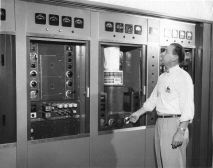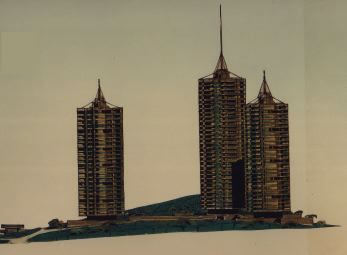History
KFMB-TV Turns 50
By Gary Stigall
KFMB-TV Staff Engineer
Their first night on the air, May 16, 1949, actually turned out to be a dud. The brand new GE transmitter was dissipating its full rated power, but very little of the RF made its way to the antenna. After signing off, Charlie Abel and the other guys, who had gathered in anticipation of a grand first day on the air, instead scratched their collective heads. They checked obvious components, in fact disconnected the whole plate circuit. They still measured a big shunt to ground.

|
Charlie Abel inspects new RCA transmitter, July 1955.
Click on it to see the full size photo, 60Kb.
|
Charlie drained some of the transmitter's cooling water into a clean cup. With the Simpson VTVM probes poked into the water, he measured only 16 ohms between the probes. The carbon tetrachloride they had used to wipe down the new cavity and cistern etched the metal pipes and vacuum tube walls. The coolant contained a conductive soup of carbon and copper ions. The plate current had been going straight to the heat exchanger.
The next day they wiped everything down with a neutralizing chemical, then rinsed it out. They filled up the cooling system three times with de-ionized water, then tested the transmitter once again. It worked. The full 5 kilowatts this time made it to the output port and on to their six-bay antenna. They signed on with "Time for Beanie," a kids' puppet show relayed from KTLA at 7:30 PM.
All About Charlie...
As a high school freshman in Eden Prairie, Minnesota in 1930, Charlie was given a piece of galena by his teacher. "I took it home and made a crystal radio." Then he experimented with vacuum tubes. "I'd go to the filling station and for two bits I'd get a car battery that someone would turn in with one or two good cells, and I'd take that home to run my radios."
He listened on a superregen to Admiral Byrd on his 1931 trip to the South Pole. "I would listen in on the make-up circuit for NBC a day before the weekly live broadcasts. He almost died that winter, you know." Charlie heard the tense story unfold week after week, until Byrd finally came out safely the next spring.
|
"...we had a plaster of paris figure of Mickey Mouse. We'd set him on a rotating pedestal and that's what we would broadcast..."
|
"I started studying television in the days of the old mechanical scanning disks. The only way you could get it is if you were on the same power plant as the person transmitting so that you could synchronize using the 60 cycles [from the line current]. At the studio, nobody could stand the heat [of the studio lamps], so we had a plaster of paris figure of Mickey Mouse. We'd set him on a rotating pedestal and that's what we would broadcast in the early days. We had to have so much light because the only pickups were not sensitive. Dr. Young, an optician in North Minneapolis, made a lens and put it on the front to increase sensitivity. Then came the iconoscope. That got better because you needed only half the light."
Then Charlie Abel moved on to California, where he worked on military projects during World War Two. He helped design the first FM SONAR for submarines, helping them penetrate the heavily mined South Seas. For Convair, he worked on guidance systems which, in tests, compared receive phase between transmitters on Mt. Soledad and Pt. mugu.
After the war, he began making and selling seven-inch screen TV's in San Diego, which he carried around town demonstrating reception of KTLA and W6XAO (later KTSL, KNXT, and now KCBS) from Los Angeles.
It didn't last long. He showed up at the Mt. Soledad site and proved to be handy. He modified a television receiver with a cathode follower in order to feed a video switcher and make the rebroadcast of L.A. stations possible. He was hired weeks before the station went on the air.
Getting Started
Facilities on Mt. Soledad were modest. Besides the transmitter and tower, they had a film chain with two film projectors, and a receiver used to rebroadcast shows from TV stations in Los Angeles.
They cherry-picked broadcasts from KTLA, and the network stations of NBC, ABC, CBS, and DuMont. Relaying KECA (now KABC) channel 7 on adjacent channel 8 was not a trivial matter. "We built a corner reflector antenna eleven feet wide with wire mesh on all sides and a dipole mounted in the vertex. It's in Terman's
Engineering Handbook.
And that's how we got channel seven and how we protected from picking up our own signal on channel eight. When channel seven went down in power, we were in trouble. Immediately we started to see leakage on their signal."
The sync generator, Charlie says, "was the old G.E. in the rack, about two-feet tall, and so loaded with 6SN7's that you couldn't get your hand in between them. The countdown had to be adjusted all the time."
"We could have had a better channel, but [KFMB owner] Jack Gross had a lot of buddies at ABC and they were in the bar drinking one night and one of the fellows said, 'So what channel are you going on?' And Jack said, 'I don't know.' And the fellow from ABC says, 'We're on seven--why don't you go on eight?' And that's how we got eight. Nobody at that meeting considered interference."
"We had remote broadcasts right from the first. One of the most popular ones were the Jai Alai games in Tijuana. We microwaved directly from the Palace to Mt. Soledad. A tenth of a watt...our first RCA microwave set. A little bread truck, that's all it was. That one ended up in Bakersfield [at another Jack Gross station, KERO]. Then we outfitted a Greyhound bus."

The Greyhound covered numerous parades and
Zoorama, a popular live show from the San Diego Zoo. They occasionally covered sports for ABC. Charlie remembers a live science show for NBC done from a General Dynamics plant, when a camera went out just before air time in a cloud of smoke. "I found a charred resistor in its huge power supply. I held a screwdriver across the resistor to restore video. The director screamed, 'That's it! Hold it right there.' And I did."
The Fabulous Fifties
After channel 10 went on the air after the lifting of the FCC-imposed "freeze" in 1952, KFMB-TV became a CBS affiliate with secondary programming from ABC. KFSD-TV (later KOGO-TV, now KGTV) broadcast primarily NBC programs.
CBS finally adopted the NTSC compatible color system and began sporadic broadcasts in 1953. "Putting color through that old G.E. five-kilowatt was a real problem. They did come up with some filters and auxiliary amplifiers, but it wasn't very good. That's when we got the new RCA."
Charlie had a 10-inch home color TV by late 1953. "When the Rose Parade came on, we had half the neighborhood in our living room."
One of his crowning achievements was the installation of an intercity microwave relay from Los Angeles in the mid-50's. Fading and noise on the television receiver used to pick up KNXT made it unreliable. The owners didn't want to pay for expensive phone company video service. "So I got busy and researched the microwave thing and none of the companies wanted to talk with me because the hop was over 65 miles. Finally, a couple of them decided they would loan me the equipment if I would pay the freight on the return trip."
They confirmed that the link was line-of-sight by having some transmitter engineers on Mt. Wilson shine a Kleig spot lamp toward San Diego. The Mt. Soledad crew saw the beam. At the time, that 129 mile link was the longest on 2 GHz in daily use. "I never sent it back." They had a 10 watt amplifier on Mt. Wilson, and a ten-foot parabolic dish, and later an additional 19-foot grid dish a few feet away, feeding a diversity device that would switch to the antenna receiving the least noise.
A studio was built in the basement of the San Diego Hotel, but moved out in 1953 because the ceilings were too low for theatre lighting. They moved to the Journal building at Fifth and Ash, and the studios were in an area once occupied by large printing presses, with high, reinforced ceilings. They stayed in that location until moving to the present Kearny Mesa site in 1977.

|
|
Architect rendering of secret Mt. Soledad rotating tower apartment project proposed for the KFMB site, about 1958. Community antenna site would have included channel 10 array. It was never built.
|
In 1951, Jack Gross sold out to Kennedy Broadcasting for $1.5-million. They sold again in 1953 to Wrather-Alvarez. When the Wrather-Alvarez partnership broke, Jack Wrather, producer of Lassie, continued ownership as majority owner of Marietta Investment. In 1959, Marietta merged with Transcontinent TV, who owned the station until it was purchased by August Meyer and Midwest Television in 1964.
Charlie Abel, now 83, retired from Midwest Television in 1979, but checked in once a week for another 13 years. He lives in North Park, where he gets to spend time with his church and his family. He's a Life Member of SBE. Sadly, this winter he lost Bea, his wife of 57 years, to lymphoma. He listens to German news on Deutsche Welle, and occasionally gets on ham radio as W6QAK. And he's getting ready to buy a new iMac.
|

